Day 02 GAZIANTEP April 18, 2010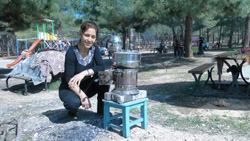
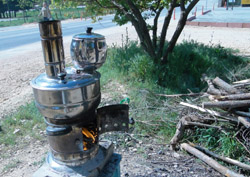 Sunday
Sunday
We started at 03:30 in Istanbul. The flight was off
from the new airport on the Asian side of Istanbul, Sabiha Gokcen Airport.
The air port was well organized, immaculately clean and very efficient. The
flight arrived in Gaziantep on time. We were all ready for a good breakfast, 5
hours after we had started in Istanbul this morning. The ancient city of
Gaziantep is catching up with the changing world. Trying to change her
image; a speed train line is being built. They have the biggest zoo of Turkey
and the city is being adorned with many parks. We chose to have our breakfast at
one of these new public parks. When we approached the park, we saw piles of
charcoal. That was the first sign of what would be going on in the park . The
families were coming here for picnic and the charcoal was for their
samovars. For many cultures picnic might be associated with barbeque, but in
Turkey, having a good picnic means having nice tea prepared in samovars.
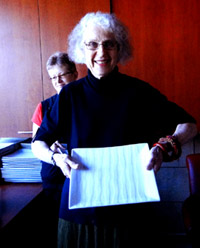
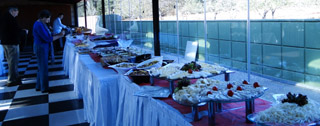
We headed for a modern building with a huge
garden. The first shock was the size of the plates. Obviously we were
going to have a serious breakfast. In the cheese bar we counted 10 different
cheeses. The buffet table was 50 feet long. The dishes were jammed on the table.
There were at least 20 different type of breads. We knew we were not going to
starve this morning.
After a nice relaxing breakfast, we headed towards our hotel. Along the way, we
saw some posters announcing the brand knew City Museum that was opened at the
historic BEYAZ HAN. We all agreed that we should give it a try and visit the
museum.
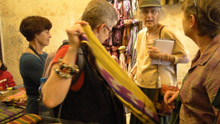
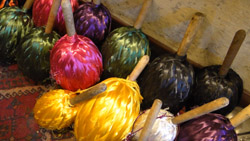 Beyaz
Han was one of many craft centers of Gaziantep since the 17th Century. The
second floor of the building is now the city museum.
Beyaz
Han was one of many craft centers of Gaziantep since the 17th Century. The
second floor of the building is now the city museum.
The craftsman of Gaziantep still use the rooms around the courtyard to display
and produce their hand crafts.
The jewelry makers, the yemeni (leather shoes), lace shops and weavers were all
trying to exist in the traditional setting surrounded by an industrialized city.
the most popular shop was where Turkish Ikat, Kutnu kumas was being sold.
The colors of silk died with natural dies made every
 scarf
more attractive. It seemed like every one in the group found the right color for
them selves. This was an unexpected but well worthed stop. The City Museum gave us a nice idea of the
traditional life in Gaziantep. The history of the city was well illustrated with
photographs and mannequins. The baklava makers, the weavers, the kitchen
utensils, the silk weavers and shoe makers were all demonstrated in small rooms
.
scarf
more attractive. It seemed like every one in the group found the right color for
them selves. This was an unexpected but well worthed stop. The City Museum gave us a nice idea of the
traditional life in Gaziantep. The history of the city was well illustrated with
photographs and mannequins. The baklava makers, the weavers, the kitchen
utensils, the silk weavers and shoe makers were all demonstrated in small rooms
.
By the time we left the
museum, we all had a pretty good idea of what to expect of Gaziantep for the
rest of our stay in this city.After a short drive, we went to a neighborhood where we were
suppose to find wood carvers. the minute we put our step off the bus, we
heard the sound of an instrument that the group could not figure out what it
was. they thought it was a bag pipe.
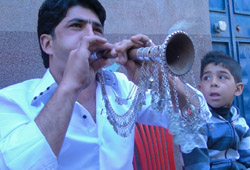
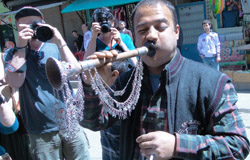 Meli told the group that there must be a
wedding in the neighborhood and she suggested that we should go and see what was
going on. As we walked towards where the music was coming, we saw women looking
out from the windows and balconies. Red plastic chairs were being arranged on
the street and two zurna players were blowing
Meli told the group that there must be a
wedding in the neighborhood and she suggested that we should go and see what was
going on. As we walked towards where the music was coming, we saw women looking
out from the windows and balconies. Red plastic chairs were being arranged on
the street and two zurna players were blowing
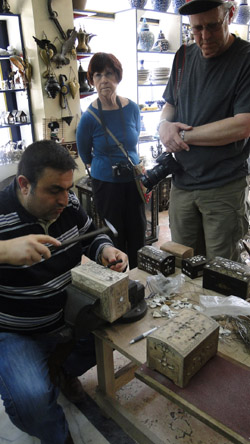 had
in their instruments adorned with silver necklaces.
had
in their instruments adorned with silver necklaces.
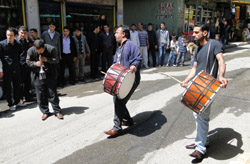
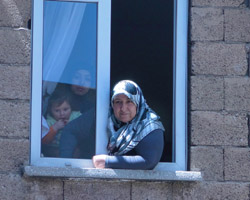 The
drummers were banging on their drums accompanying the
zurna players and the young men were lined up dancing in
the street . It was a perfect photo opportunity. We noticed that the street was
blocked to traffic with a car parked sideways on each end of the street. We
found out that the dancing and the wedding ceremony would last all day
until the last call to prayer.
The
drummers were banging on their drums accompanying the
zurna players and the young men were lined up dancing in
the street . It was a perfect photo opportunity. We noticed that the street was
blocked to traffic with a car parked sideways on each end of the street. We
found out that the dancing and the wedding ceremony would last all day
until the last call to prayer.
The mother of pearl inlayed in wood is another
craft that is popular in Gaziantep. We visited a work shop to see how this craft
is still kept alive. The gentleman who was demonstrating had told us that he has
been doing this job since he was twelve years old. He complained about not being
able to find apprentices any more. He claimed that this was a dying art.
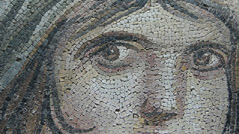 Our next stop was the amazing Zeugma museum.
Our next stop was the amazing Zeugma museum.
Zeugma was a roman city built on the Euphrates river on the cross roads
of the Trade roads. the wealth of the city had reflected
on the beautiful houses which we adorned with mosaics
on the floors and the frescoes on the walls. The rich
colors of the natural stones in the
riverbeds of Euphrates and the
talented artists of the city made it possible for these huge mosaics to be the
most colorful mosaics of the
Roman era. The most popular of the mosaics was the face of a gypsy
woman. The bronze statue of Aris is
a unique statue with his silver inlaid eyes.
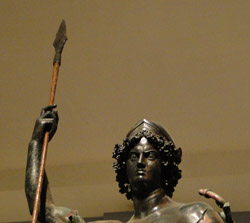
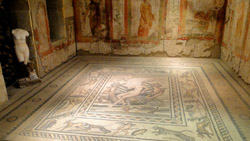
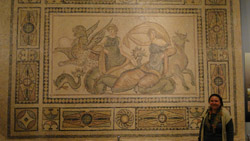
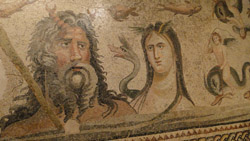
Our next stop was the heart of the old city
where you can find your way listening to the sound of the hammers of the
coppersmith. After a wonderful lunch we headed to the Bakircilar Carsisi- the
coppersmith's market.
For lunch, we had local dishes: Lahmacun (very thin bread with meat and
tomato paste), Chicken Shish Kebab, Alinazik (eggplant meat and yogurt).
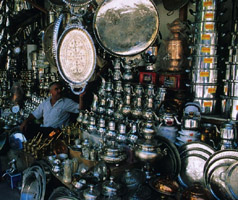
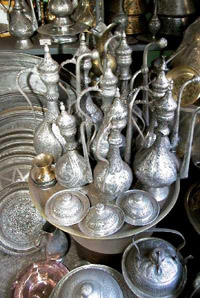
We spent the rest of the afternoon in the coppersmiths street/
some of the copper smiths on this street were the 6th generation craftsmen
working in the same shops as their ancestors had worked.
One could hear the sound of the hammer
pounding on the copper plates from the other street
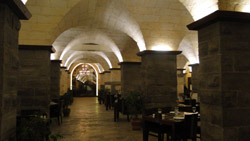
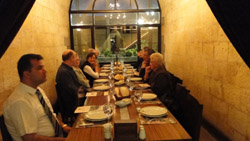 The
dinner was at a 18th Century han. It used to be the place where the dried
vegetables were stored and sold. Our dinner was appropriate for the setting. The
reciepies of the food that we were served were all at least 200 years old.
The
dinner was at a 18th Century han. It used to be the place where the dried
vegetables were stored and sold. Our dinner was appropriate for the setting. The
reciepies of the food that we were served were all at least 200 years old.
At the end of the day we were very happy and
ready for the next day.
Next page
Melitour home page

 Sunday
Sunday


 Beyaz
Han was one of many craft centers of Gaziantep since the 17th Century. The
second floor of the building is now the city museum.
Beyaz
Han was one of many craft centers of Gaziantep since the 17th Century. The
second floor of the building is now the city museum. scarf
more attractive. It seemed like every one in the group found the right color for
them selves. This was an unexpected but well worthed stop. The City Museum gave us a nice idea of the
traditional life in Gaziantep. The history of the city was well illustrated with
photographs and mannequins. The baklava makers, the weavers, the kitchen
utensils, the silk weavers and shoe makers were all demonstrated in small rooms
.
scarf
more attractive. It seemed like every one in the group found the right color for
them selves. This was an unexpected but well worthed stop. The City Museum gave us a nice idea of the
traditional life in Gaziantep. The history of the city was well illustrated with
photographs and mannequins. The baklava makers, the weavers, the kitchen
utensils, the silk weavers and shoe makers were all demonstrated in small rooms
.
 Meli told the group that there must be a
wedding in the neighborhood and she suggested that we should go and see what was
going on. As we walked towards where the music was coming, we saw women looking
out from the windows and balconies. Red plastic chairs were being arranged on
the street and two zurna players were blowing
Meli told the group that there must be a
wedding in the neighborhood and she suggested that we should go and see what was
going on. As we walked towards where the music was coming, we saw women looking
out from the windows and balconies. Red plastic chairs were being arranged on
the street and two zurna players were blowing
 had
in their instruments adorned with silver necklaces.
had
in their instruments adorned with silver necklaces.

 The
drummers were banging on their drums accompanying the
zurna players and the young men were lined up dancing in
the street . It was a perfect photo opportunity. We noticed that the street was
blocked to traffic with a car parked sideways on each end of the street. We
found out that the dancing and the wedding ceremony would last all day
until the last call to prayer.
The
drummers were banging on their drums accompanying the
zurna players and the young men were lined up dancing in
the street . It was a perfect photo opportunity. We noticed that the street was
blocked to traffic with a car parked sideways on each end of the street. We
found out that the dancing and the wedding ceremony would last all day
until the last call to prayer.
 Our next stop was the amazing Zeugma museum.
Our next stop was the amazing Zeugma museum.






 The
dinner was at a 18th Century han. It used to be the place where the dried
vegetables were stored and sold. Our dinner was appropriate for the setting. The
reciepies of the food that we were served were all at least 200 years old.
The
dinner was at a 18th Century han. It used to be the place where the dried
vegetables were stored and sold. Our dinner was appropriate for the setting. The
reciepies of the food that we were served were all at least 200 years old.